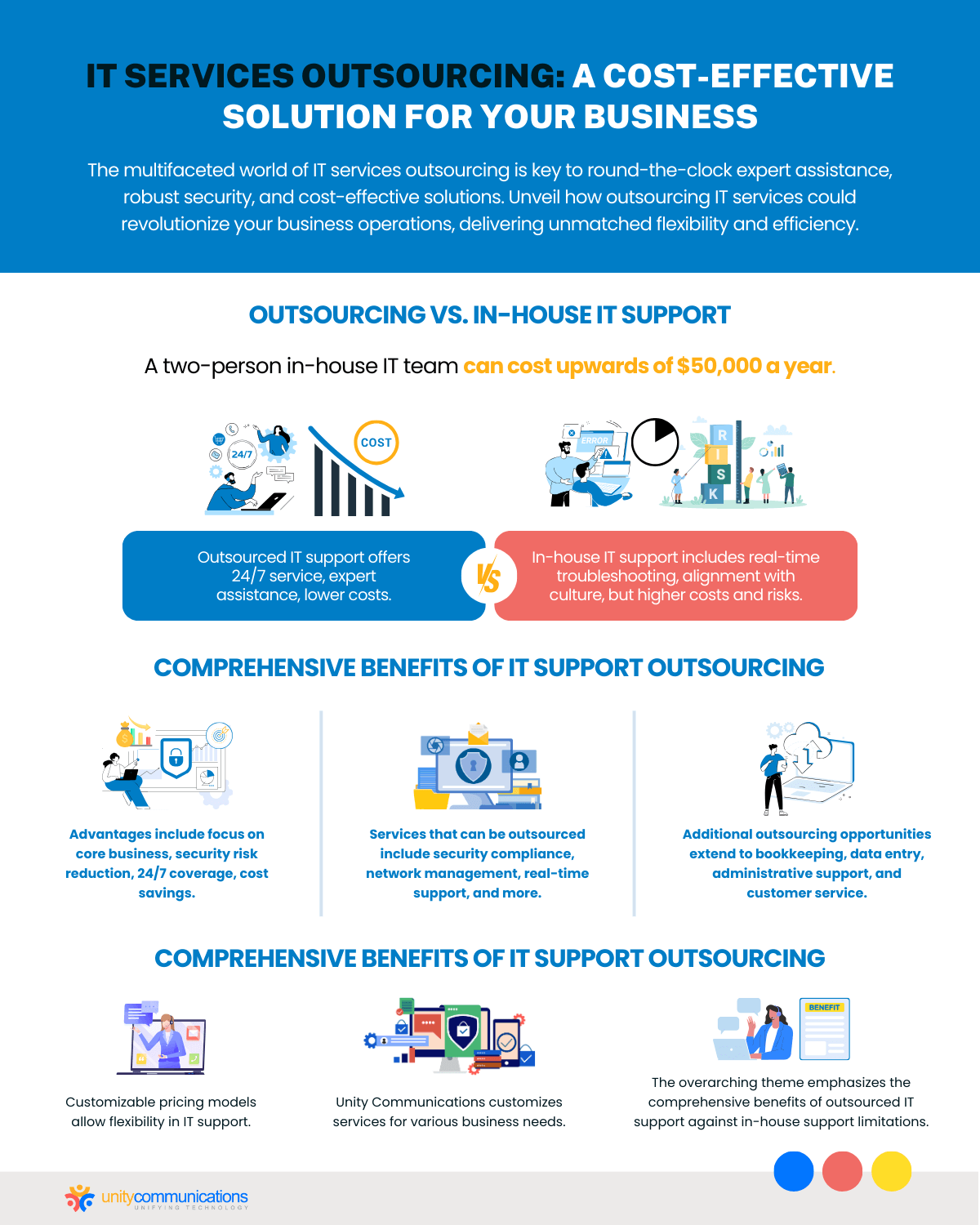Table of Contents
Superior technical support is crucial to establishing a loyal customer base for information technology (IT) and technology firms. This process requires skilled help desk agents and modern technology to accommodate increasing demands. But companies must spend more to establish an in-house team.
Outsourcing is a cost-effective solution to provide an excellent customer experience. IT and technology businesses hire third-party service providers to handle technical support. They can then focus on enhancing their core capabilities and primary offerings.
But which business approach – outsourcing tech support or keeping it in-house – delivers the most benefits? How different are they? Find out through this article about in-house vs. outsourced technical support.
Cost

Companies must allocate significant upfront capital to establish an in-house tech support team. They must dedicate enough funds to recruit and train the best talent for the job. They must also provide adequate compensation, benefits, and incentives to retain their skilled workers.
IT firms acquire modern technology and infrastructure to help agents complete their tasks efficiently and quickly. They invest in office space to house their tech support staff. Providing a comfortable workplace and easy-to-use systems helps motivate employees to perform their duties.
Despite tech support’s importance in wooing customers, it is still considered a non-core task. It only indirectly contributes to continued business growth. So spending a chunk of dollars on this business process isn’t necessarily considered essential.
Outsourcing offers a solution to close such gaps at affordable costs. According to Deloitte, 88% of 600 polled organizations identified cost reduction as one of the most tangible benefits of outsourcing. Working with a tech support provider does not require companies to form an in-house team or buy niche equipment.
Third-party service providers already employ highly trained employees and use the latest technology. Businesses can choose to sign a fixed contract to acquire tech support payable through monthly billing. They can also select a variable setup where they only pay for that service when needed.
Expertise and Brand Awareness
Expertise and brand awareness are vital when discussing in-house vs. outsourced technical support. Companies must ensure that they get workers well-versed in this field. They need agents capable of providing tech support effectively to keep customers coming and returning.
Because agents act as contact points for customer inquiries, they need deep knowledge of products and services. In-house workers can quickly familiarize themselves with the offerings. They learn about company values and objectives beforehand to understand the products’ purpose.
In-house agents undergo training to achieve the technical expertise desired by their companies. But they might struggle to maintain their performance when they have backlogs and other tasks. If they miss regular training sessions, their responsiveness might diminish or their knowledge base becomes out-of-date.
Outsourced tech support agents also receive regular training and certification to meet their clients’ expectations and demands. Contractors ensure that their agents can provide effective tech support via multiple communication channels.
But third-party employees might not fully grasp IT firms’ products and services compared to in-house personnel. The former can improve their brand knowledge with proper training and hands-on experience. This capability helps them deliver a more personalized experience for customers.
Size

IT and technology companies must consider the size of a workforce and office space when deciding on in-house vs. outsourced technical support. This factor helps them decide whether to facilitate agents in-house or hire them from third-party service providers.
Regarding the team’s size, businesses must examine their capacity to manage many tech support employees in the long run. If they have a small customer base, these firms can outsource their tech support instead of building an in-house unit. They can save on costs by recruiting and training personnel and acquiring office space and technology.
Businesses of all sizes might also face challenges handling a large-scale tech support team. They might struggle to oversee an in-house customer service function while working on improving their core capabilities. Companies can adopt front-office or back-office outsourcing to reduce costs and increase efficiency in managing a big tech support team.
Technology
Another critical factor to consider when tackling in-house vs. outsourced technical support is technology. Aside from having a skilled workforce, IT and technology firms need up-to-date infrastructure to provide a superb customer experience. They must establish workstations, telephone lines, and fast internet connectivity to streamline customer service.
Robotic process automation (RPA), artificial intelligence (AI), cloud computing, and social media help companies speed up their response to consumer inquiries. An omnichannel solution also enables them to deliver customer-centric tech support 24/7. These capabilities allow them to attain customer satisfaction and retention.
Businesses need to allot significant funds to optimize such advanced systems. They also have to spend extra dollars on maintenance, repair, and modernization. All are costly investments for a non-core function.
Hiring tech support contractors offers an affordable way to maximize the technology and infrastructure. IT and technology companies can pay for a fixed monthly billing upon signing an official service agreement with tech support providers or opt for a different form of billing.
Quality Control

Following quality control procedures helps organizations ensure that customers receive an unmatched tech support experience. These steps include training personnel, developing customer service quality benchmarks, and establishing well-defined controls. They help companies limit errors and standardize quality issue resolutions.
Moreover, quality control has a positive impact on employee conduct. Knowing that they’re participating in a quality-controlled process motivates agents to provide high-quality service for greater customer satisfaction. Companies should explore how they can achieve quality control when choosing between in-house and outsourced technical support.
Businesses can simplify quality control if they form a tech support team in-house. They can easily supervise agents to adhere to quality control policies. Holding regular training sessions also helps inform employees of related updates and changes.
But quality control for outsourced tech support might be challenging to maintain, especially if vendors operate offshore. Third-party service providers have different approaches to delivering quality customer service. Varying government rules, time zones, and cultural perspectives might also affect contractors’ performance.
Companies must align their management strategies to guarantee quality control with outsourcing providers. This step is vital to avoid misunderstandings and conflicts.
Scalability
As a business grows, its customers facing technical issues seek support from agents. Businesses experience backlogged customer inquiries, especially during peak season. They struggle to enhance their core offerings while addressing consumer demands.
So IT and technology companies must emphasize scalability in deciding whether to adopt in-house vs. outsourced technical support. They have to ensure optimal performance despite the pressure of increasing workloads. They must also be able to adjust their operational strategies during low and high periods.
An in-house tech support team can be sufficient for off-season transactions. Because there’s less work, companies don’t need to hire more people, add more resources, or expand office space. But when agents receive more requests than usual, they might get overworked and perform inefficiently.
This poor performance can drive away loyal customers. Zendesk reported that 61% of 3,500 polled consumers would switch to other companies after just one bad customer experience. Businesses seek outsourcing firms to quickly scale up their tech support teams and avoid such issues.
Contractors can adapt to sudden market changes and trends to meet customer demands. Depending on their client’s needs, they can provide a fixed or flexible number of employees and systems at reasonable costs. IT and technology firms can then prioritize their primary activities while reducing expenses.
Productivity

When weighing in-house vs. outsourced technical support, companies must not forget how they can maximize productivity. Remember that tech support is a non-core task. It only indirectly drives increased profitability, though it remains essential to building a loyal customer base.
Delegating tech support to third-party service providers helps companies boost their productivity without spending more. Third-party agents train to respond to customer concerns effectively. They also use advanced systems to automate and deliver tech support 24/7.
This gives technology and IT businesses sufficient time to work on their core products and services. They can even use vendor-collected customer feedback to refine their offerings. This increased efficiency enables companies to achieve customer satisfaction and retention.
An in-house tech support unit can also provide such advantages but minimally. Third-party agents must undergo frequent training to enhance their skills and update their knowledge of the latest market trends. They also require constant supervision to ensure they adhere to company policies and perform tasks excellently.
While they can meet customer expectations, in-house teams might hinder their employers’ enterprise growth priorities. Companies must prepare for regular training sessions and deal with core programs simultaneously. If things don’t go as planned, they might experience project delays and inefficiencies.
Availability
Support availability is crucial in maintaining customer satisfaction and driving business success. If consumers struggle to get to tech support, especially during peak hours, they might shift to a company’s competitors. Organizations must consider agent availability when comparing in-house vs. outsourced technical support.
Forming an in-house tech support team is the right option if businesses prioritize on-site availability. They can easily organize their agents’ schedules and workloads to ensure superb performance. They can also host emergency meetings and implement sudden changes to address immediate operational needs.
However, in-house employees can’t be available around the clock unless a company staffs a 24/7 support desk. And if they do not, companies must adequately compensate their agents if they work overtime, resulting in additional expenses.
By procuring front-office or back-office outsourcing services, businesses can benefit from 24/7 tech support. Vendors train their agents to adapt for round-the-clock customer service. They also have sufficient head counts to fill absences and work efficiently during peak season.
But outsourced tech support is not ideal when companies need to execute unexpected restructuring. They might face implementation delays because their providers have different business hours, especially when they operate offshore. The two parties then need to align their strategies to avoid such conflicts.
Language and Culture

A good tech support team understands and uses its target audience’s language and culture. This allows companies to personalize tech support. But if organizations fail to provide a personalized experience, Twilio Segment warned that 45% of polled consumers would leave and move to other businesses.
Companies must select which technical support approach can best address language and cultural differences. Customer demographics, market reach, and personalization are essential in choosing between the two business strategies.
An in-house tech support team can have an advantage over local consumers. In-house agents can provide a personalized customer experience if businesses operate domestically. Because they share the same culture and language, employees understand what customers prefer related to their tech needs.
Outsourcing, on the other hand, offers more flexibility when resolving tech issues. Vendors train their agents to adapt to different cultures and speak multiple languages. These capabilities ensure personalization when delivering tech support.
Companies serving customers worldwide can consider outsourced tech support. Contractors help streamline personalized responses to international customers without compromising service quality. IT and technology firms can ensure customer satisfaction while paying affordable service charges.
Data Security
Both in-house and outsourced technical support deal with massive amounts of customer data. Agents collect personally identifiable information, transaction details, and other relevant data from customers to address their concerns appropriately. Because consumers mostly submit inquiries online, their data is exposed to varied cyber threats from malicious actors and hackers.
According to IBM, compromised credentials caused a 20% share of breaches in 2021. The company also estimated the global average total data breach cost of $4.24 million for the same year.
If companies don’t strengthen their security, they can suffer from the high expense of losing confidential data and mitigating information leaks. They might also lose their clients’ trust and loyalty.
An in-house tech support team enables companies to monitor customer data closely and smoothly implement strict security measures. They can also personally advise and remind their workers regarding the importance of protecting customer information. But using advanced security software and employing full-time specialists are costly.
Businesses can outsource their tech support to achieve the same or enhanced level of security at affordable costs. Because contractors need to maintain their good market reputation, they follow stringent policies and procedures to protect customer data.
Compliance

Adhering to industry, national, and international regulations and policies defines corporate compliance. It serves as a pillar for establishing a good market reputation. Loyal customers, partners, and investors worldwide don’t come overnight, so companies want to be in compliance to create long-term relationships.
Companies must ensure compliance with all laws, ethical practices, and standards regardless of their in-house or outsourced technical support decisions. Rule violations can result in sanctions, lawsuits, and damaged reputations.
IT firms can achieve compliance by establishing an in-house team or outsourcing tech support. Businesses and their third-party service providers develop programs to organize their compliance policies and procedures. They even unify their rules and regulations to meet industry and government requirements.
For example, when companies decide to outsource data entry, they communicate with their providers to develop and execute a combined compliance technique. This strategy assists them in identifying and preventing violations of customer data privacy. Such an action can help build customer trust and loyalty.
Turnaround Time
Tech support doesn’t only involve responding to varied customer complaints, concerns, and questions. It also includes other relevant tasks such as data entry, status reporting, and customer feedback analysis. Although these activities are all time-consuming and labor-intensive, they help inform improvements in companies’ products and services.
Whether front-office or back-office processes, businesses need to value how quickly agents complete their tasks to avoid delays. They can experience increased efficiency and continued growth. Businesses must consider project turnaround time when deciding whether to get in-house or outsourced technical support.
Both in-house and third-party agents must accomplish their assignments on time. They have to answer inquiries in real time to avoid customer dissatisfaction. They must also submit necessary reports on other tasks, such as customer rating collection and analysis to further enhance their employers’ offerings.
But when they have other tasks, in-house agents might not always meet their deadlines. If there’s insufficient staffing, especially during holidays and vacation times, they might handle additional assignments to ease other teams’ heavy workloads. They get overworked, leading to poor performance.
Businesses hire third-party tech support providers to ensure consistent, high-quality output without delays. They also outsource data entry services and other non-core tasks to prioritize their core capabilities. This measure enables their in-house employees to focus on regular activities and avoid burdensome work.
Six Benefits of Combining In-house and Outsourced Technical Support

Businesses of all sizes might encounter challenges when choosing between in-house and outsourced technical support. They must consider a variety of factors when deciding which to adopt. Thinking these factors through helps ensure that businesses look at the big picture.
What if companies can combine both strategies? Read below to see the advantages of integrated in-house and outsourced tech support teams.
1. Cost-effective Expansion
Companies can benefit from extra skills and up-to-date systems if they combine their in-house tech support team with a third-party workforce. This advantage is especially vital during peak season. Businesses can easily tap into additional resources from their third-party service providers without spending significantly more dollars.
Because contractors already have well-trained agents and use advanced systems, businesses don’t have to add more resources and people in-house. They can pay their providers a fixed cost when extra help is necessary. They also can opt-out every time vendors complete their work.
2. Balance Workloads
Uniting in-house and outsourced technical support helps businesses balance their non-core and primary tasks. Both in-house and third-party agents can respond to customer inquiries quickly and efficiently using advanced tech support solutions, enabling a company to focus on driving growth.
Even during hectic periods, businesses can still work on improving their primary offerings. Third-party agents can support in-house tech support representatives to meet increasing customer demands. These measures can result in a superior tech support experience for customers.
3. Enhance Flexibility
Having in-house and outsourced tech support teams improves companies’ ability to adapt to changing customer demands. They can remain competitive and drive profitability while delivering outstanding tech support.
An in-house unit suits work for the off-season, while a third-party team fits activities during peak season. Because they’re familiar with customer preferences, third-party service providers can also help companies adjust and align their business strategies to match current market trends.
4. Share Insights
Despite the significant differences between in-house and outsourced technical support, companies can unite these teams through data sharing. This approach offers positive outcomes for both parties.
The most common benefits of data sharing are in economics. Service providers and hiring companies can exchange insights regarding customer feedback and performance analysis to inform their strategies, helping a company produce marketable products and services to drive continued success.
5. Personalize Help Desk
In-house and contractor agents jointly aim to deliver personalized tech support for customers. In-house employees are familiar with their local consumers’ preferences and interests to serve them appropriately. But when a company reaches a global market, it needs support from third-party agents who are familiar with the newly expanded customer base.
Instead of only having an in-house or outsourced tech support team, companies can have both to satisfy their national and international customers’ needs. This inclusive strategy can help businesses attract and retain more loyal customers.
6. Strengthen Security
Integrating in-house and outsourced tech support teams enable companies to strengthen their security. Technology and IT firms and outsourcing providers implement strong security rules and regulations to combat growing cyber threats and can even match each other’s strategies for more robust protection.
If there are gaps, both parties can fill them with varied cybersecurity measures. Suppose companies lack security solutions; third-party service providers offer advanced systems to safeguard customer and enterprise data.
The Bottom Line

IT and technology companies have different approaches to providing superior technical support depending on available resources and needs. They can form an in-house team if they can accommodate the high expense of hiring agents and deploying infrastructure. But if growth tops their priority list, they can hire contractors to handle their help desks.
Companies must consider various factors to ensure optimum results when setting up an in-house or a third-party team, from saving costs to avoiding delays. They must carefully differentiate the benefits and drawbacks of adopting in-house or outsourced tech support to ensure returns on their investments.
Another approach to optimize in-house and outsourced tech support teams is to combine them. Although it seems costly, integrating these strategies can help businesses scale up and meet customer demands effectively. Whether combined or not, in-house and outsourced tech support units help attain customer satisfaction and retention.




